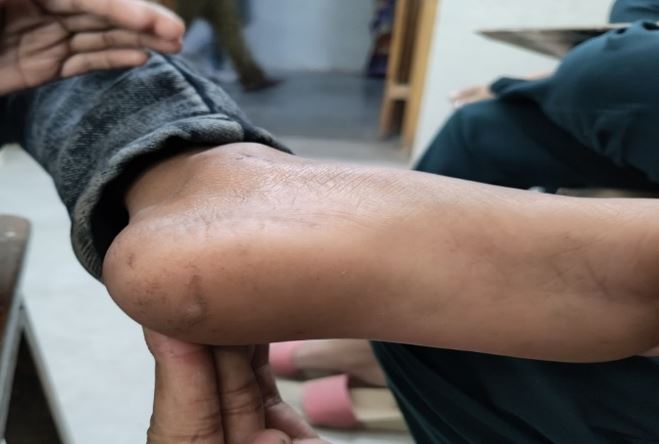Management of Vipadika - A Case Study
DOI:
https://doi.org/10.21760/jaims.10.9.42Keywords:
Vipadika, Ayurveda, Case report, Kshudra KushthaAbstract
Introduction: Kustha[1] is a broad term, as it covers all skin diseases mentioned in Ayurvedic texts. Vipadika[2] is one among such disease which has been included under the heading of Kshudra Kushta. It is characterized by Pani-Pada Sphutan[3] (Fissure in palm and soles) and[4] Teevra Vedana[5] (with severe pain). It affects the individual because of unstable life style, dietary pattern, stressful life. Vata, Kapha and Pitta/Rakta[6] vitiation are major cause in its manifestation. Pitta can overheat the blood (Rakta dhatu) and predispose to toxic conditions which are expressed through the skin. So, line of treatment should be to remove Dushit Pitta from the body and Shuddhi of Rakta Dhatu.
Methods: In present case report a 12-year-old male child patient came to our Kaumarbhritya OPD at Government Ayurved hospital Nanded with complaint of dryness and cracking of both soles associated with Inflammation and pain in the past 1 year. After examination the is diagnosed as Vipadika. A treatment of 1 month included Jeevantyadi Yamaka Lepa with Internal medication.
Result: Assessment of the patient was done for 30 days with Ayurvedic treatment.
Discussion and Conclusion: Vipadika can be successfully treated with appropriate Ayurvedic medication as per Kushtha Chikitsa [7] mentioned in Ayurveda Texts.
Downloads
References
Tripathi R. Charak Samhita. Vol. 2. Varanasi: Chaukhamba Sanskrit Pratishthan; 2010. p.182. Adhyaya 7, Shlok 10.
Tripathi R. Charak Samhita. Vol. 2. Varanasi: Chaukhamba Sanskrit Pratishthan; 2010. p.185. Adhyaya 7, Shlok 29.
Tripathi R. Charak Samhita. Vol. 2. Varanasi: Chaukhamba Sanskrit Pratishthan; 2010. p.184. Adhyaya 7, Shlok 22.
Tripathi R. Charak Samhita. Vol. 2. Varanasi: Chaukhamba Sanskrit Pratishthan; 2010. p.184. Adhyaya 7, Shlok 22.
Garde G. Sarth Vagbhat Nidansthan. Pune: Anmol Prakashan; 2007. p.206. Adhyaya 14, Shlok 14.
Tripathi R. Charak Samhita. Vol. 2. Varanasi: Chaukhamba Sanskrit Pratishthan; 2010. p.182. Adhyaya 7, Shlok 10.
Charaka A, Sastri SS, editor. Charaka Samhita. Part 2. Varanasi: Chaukhamba Bharati Academy; 2002. p.252. Kushta Chikitsa Adhyaya, Chapter 7, Verse 22.
Tripathi R. Charak Samhita. Vol. 2. Varanasi: Chaukhamba Sanskrit Pratishthan; 2010. p.182. Adhyaya 7, Shlok 10.
Garde G. Sarth Vagbhat Sutrasthan. Varanasi: Chaukhamba Surbharati Prakashan; 2014. Adhyaya 1.
Charaka A, Sastri SS, editor. Charaka Samhita. Part 2. Varanasi: Chaukhamba Bharati Academy; 2002. p.252. Kushta Chikitsa Adhyaya, Chapter 7, Verse 22.
Tripathi B. Ashtang Hrudayam. Nidan Sthan, Chapter XIV. Delhi: Chaukhamba Sanskrit Pratishthan; p.530.
Garde G. Sarth Vagbhat Nidansthan. Pune: Anmol Prakashan; 2007. p.206. Adhyaya 14, Shlok 14.
Shastri AD. Sushrut Samhita. Varanasi: Chaukhamba Sanskrit Pratishthan; 2013. Nidansthan 13, Sutra 28.
Shastri AD. Sushrut Samhita. Varanasi: Chaukhamba Sanskrit Pratishthan; 2013. Nidansthan 13, Sutra 28.
Shastri AD. Sushrut Samhita. Varanasi: Chaukhamba Sanskrit Pratishthan; 2013. Nidansthan 13, Sutra 28.
Garde G. Sarth Vagbhat Chikitsasthan. Varanasi: Chaukhamba Surbharati Prakashan; 2014. p.320. Adhyaya 19, Shlok 77–78.
Humbare RB, Sarkar J, Kulkarni AA, Juwale MG, Deshmukh SH, Amalnerkar D, et al. Phytochemical characterization, antioxidant and anti-proliferative properties of Rubia cordifolia L. extracts prepared with improved extraction conditions. Antioxidants (Basel). 2022 May 20;11(5):1006. doi: 10.3390/antiox11051006. PMID: 35624869; PMCID: PMC9137611.

Published
How to Cite
Issue
Section
License
Copyright (c) 2025 Akshay M. Bharane, Vijaykumar U. Gawai

This work is licensed under a Creative Commons Attribution 4.0 International License.














